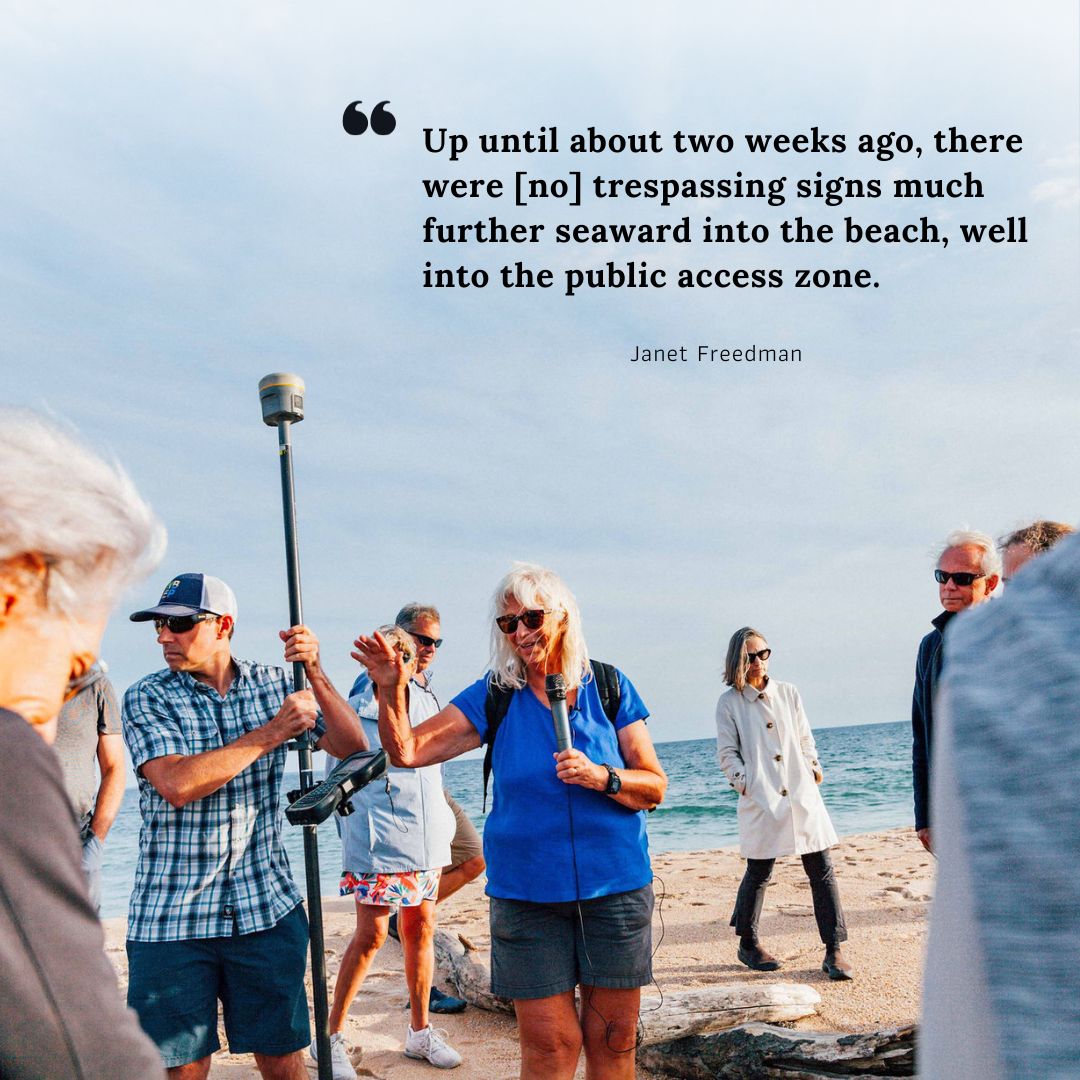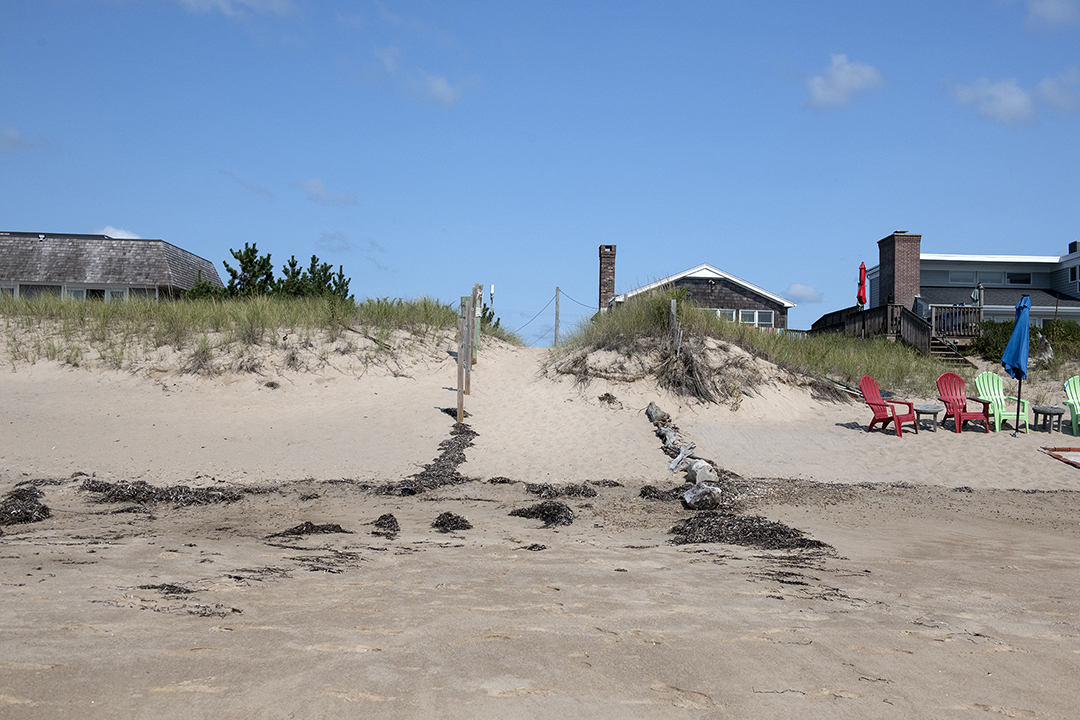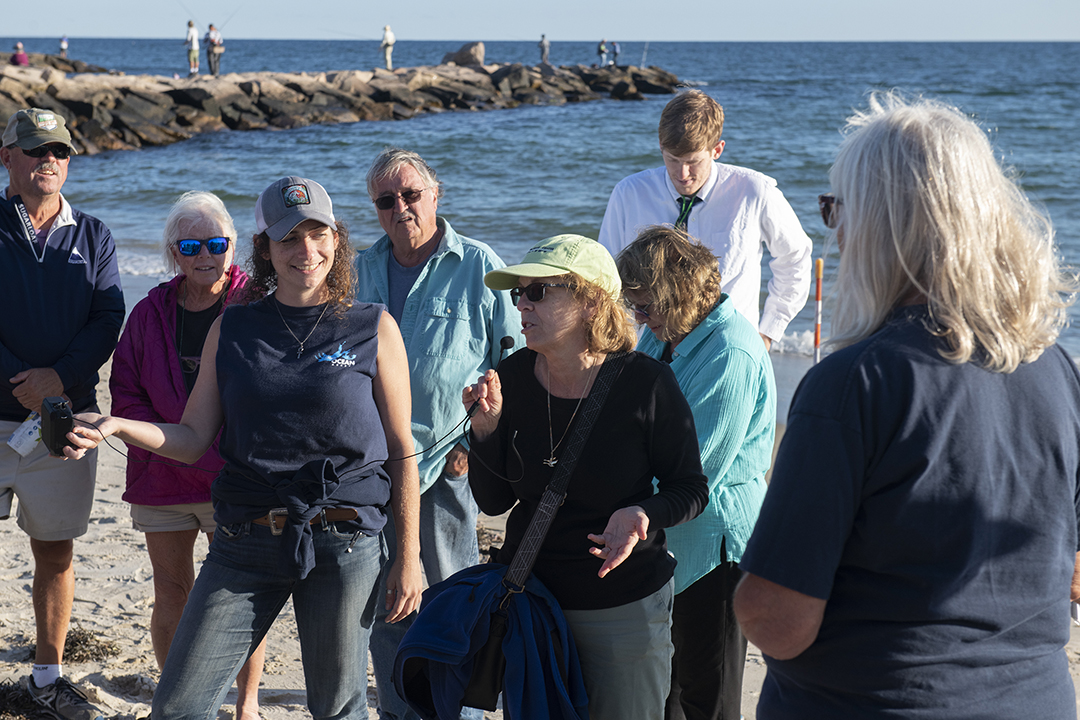
We want to thank our partners and all of the community members who joined the Coastweeks East Beach Walking Tour to discuss lateral access issues to the shoreline.
“The seaweed line plus the 10 feet gives the public more access than they have had [if not for the Supreme Court ruling in 1982],” said Sen. Mark McKenney during the tour. He was referring to the case State v. Ibbison, which determined the boundary for public access was set at the mean high water (MHW) line–a near-invisible line that required nearly 20 years of data to accurately place.
McKenney, who sponsored the recent bill that was passed, originally wanted the boundary to extend to the vegetation. “All in all, what we passed this year is a very realistic and discernible and usable, workable boundary,” he said despite continued conflict with homeowners and a recently dismissed lawsuit.
McKenney was joined by other speakers who discussed how data was collected and used, aspects of a changing shoreline, and challenges moving forward.
Janet Freedman, a @URI_CoastalInstitute senior fellow, and retired CRMC coastal geologist, discussed dune and coastal ecology and how that interacts with the new law, along with challenges for the future because the shore is changing, which means so is the mean high tide line.
“Up until a two weeks ago, there were [no] trespassing signs much further seaward into the beach, well in to the public access zone,” she said.
“It moves all the time,” said Nathan Vinhateiro, @URI_CoastalInstitute science director, in a report by the Westerly Sun. “Because this is not what the beach looks like all the time.”
BACKGROUND
Below is a breakdown of what this law means, as well as tips for advocates and the webinar sponsored by the Rhode Island Coastal Resources Management Council (CRMC) and Rhode Island Sea Grant.

Problem 1: Where is the Shoreline?
The problem with this boundary is that it is impossible to visually determine but rather requires scientific instrumentation to precisely locate. And along Rhode island’s dynamic shorelines, this line is frequently underwater, despite the common understanding that “high tide” is, well, as high as the water gets.
Problem 2: What Activities Are Protected?
“The people shall continue to enjoy and freely exercise all the rights of fishery, and the privileges of the shore, to which they have been heretofore entitled under the charter and usages of this state, including but not limited to fishing from the shore, the gathering of seaweed, leaving the shore to swim in the sea and passage along the shore[.]”
Some have interpreted this text to mean that those exercising their shoreline rights must be actively fishing, gathering seaweed, or in some way moving along – not, for instance, sitting in a beach chair with their ankles in the water. (More on this below.)
Shoreline access advocates, armed with seaweed-gathering bags or fishing poles, ready to record their encounters, have challenged those who, they believe, were trying to prevent them from exercising their rights. Charlestown resident Scott Keeley was arrested on a beach in Charlestown in 2019 for trespassing, an interaction that was captured on video. The charges were later dropped, and Keeley received $25,000 in a settlement of a lawsuit filed against the town.
Against this backdrop, Rep. Cortvriend was searching for a way to introduce sea level rise legislation at the General Assembly, she told the webinar audience. Colleagues drew her attention to the Keeley case, and her subsequent research showed her that the issue of lateral shoreline passage was an important one to many Rhode Islanders.
After teaming up with then-Rep. Blake Philippi, she approached House Speaker Joseph Shekarchi about a bill to address shoreline access issues. He told her that due to the controversy around the issue, she should establish a study commission.

The commission heard from Nathan Vinhateiro and Janet Freedman of the URI Coastal Institute about the difficulties of establishing where the mean high tide was without using specialized equipment.
McKenney recalled being asked to help resolve shoreline access disputes between beach goers and property owners in his coastal neighborhood in Warwick, and how even police responding to allegations of trespassing were frequently confused.
He said that one thing the commission discovered that helped persuade him of the need for the bill was that in the over 40 years since the Ibbison case,
“there have been no successful prosecutions of trespassers. And that’s for a very simple reason. In order to have a successful prosecution of someone who is alleged to have trespassed, there needs to be a showing that they had criminal intent. And criminal intent means knowing that what you’re doing is against the law, and doing it anyway. So in this situation, if no one knows where the high tide line is, it’s very hard for prosecutors to prove criminal intent.”
While the senator said he expects challenges to the law, he added that the U.S. Supreme Court recently declined to hear a case from Indiana, where, he said, the lower courts had
“established fairly strongly that if a legislature, as the highest authority in a state, takes action to clarify a confused situation—such as Indiana had on Lake Michigan with respect to where the public could access around the lake and such as we have on our shoreline—their action taken to clarify that confused situation deserves considerable deference from the courts, and in essence shouldn’t be touched. So it’s our hope that having added in a little language to make it clear that this is exactly what we’re doing and clarifying that situation, that it will be viewed by the courts favorably.”
McKenney credited advocates Woods and Save The Bay’s Topher Hamblett with assisting the legislative staff in working on the bill. “We have a good staff in the legislature, but it’s not huge, and so very often we rely upon somebody advocates to be helpful. And those two were invaluable,” he said.
Tips for Advocates
1
Advocate in specific terms
“What is the change really that I want to see? Do I understand the problem well enough to convey how I want that change to happen?”
Articulating issues clearly, said Woods, helps decisionmakers write appropriate language for bills or regulatory proposals.
2
Know the responsible branch of government
Some issues are addressed by the General Assembly, like the shoreline access bill, but if you are concerned about parking at shoreline access sites, for instance, recognize that parking is regulated at a municipal level, and address your advocacy there.
3
Let them know you are a constituent
It always helps to establish your relationship to the person you are addressing, and in the case of elected representatives, that you are in a position to vote for them, Woods said.
4
Be respectful
“The way that I try to think about this is, even when I disagree—and sometimes I disagree passionately—I always try to leave a path forward from that interaction as opposed to burning a bridge,” Woods said.
What Does the New Law Permit?
“What was illegal before, was not allowed on the beach before, is not allowed,” he said. But he added that although the Rhode Island Constitution describes four rights specifically—fishing, swimming, gathering seaweed, and passing along the shore—it also says that shoreline rights are not limited to those activities.
“I have had an awful lot of the property owners, in particular, who have argued that it is allowable only to pass along the shore, that you can’t stop there. Well, I don’t think you can fish if you’re constantly moving. So passage along the shore, constant movement, is not required,” he said.
“The Constitution doesn’t require you to keep moving, and the courts are going to have, I’m sure, a fun time in explaining what ‘included but not limited’ means in terms of constitutionally protected activity.”
